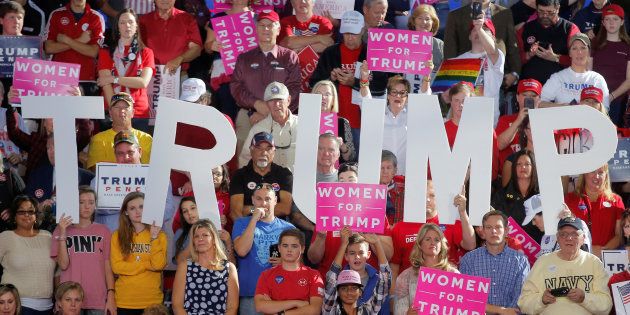

Previous Page >> 3 Tactics That Helped Donald Trump Win Hearts And Influence People
3 Tactics That Helped Donald Trump Win Hearts And Influence People

The US election is finally over, and Donald Trump is going to lead the world’s most powerful nation beginning 2017. While a close fight was expected, his win stunned many people—but the signs were there all along. Trump had successfully tapped into the emotions of blue collar workers who felt that the American dream had faded for them and that there was no one to hear their voice in Washington. To them, this “outsider” was the only one who was willing to address concerns around terrorism, trade and immigration.
He kept on repeating his message again and again, playing on the fears of the people even as he promised to solve their problems.
Here, I want to focus not on Trump’s particular messages to the people but on the tactics he used to communicate with and influence voters. In my analysis I found that Trump used three primary strategies to persuade voters—these strategies are also relevant in business and other contexts.
The fear factor
Fear can be a big motivator. And this is what Donald Trump used very well. He tried to appeal to the fears of the voters. Now, let’s not forget that fear is an adaptive emotional response to situations of threat and it motivates us to act in three basic ways—to fight or take flight. When this is not possible at the individual level people look for direction and guidance, for someone who can fight for them. This is exactly what happened in Donald Trump campaign.
His message primarily revolved around the economy, falling wages, income stagnation, politicians not being able to get things done, corrupt federal government, things being broken in Washington, other countries taking the US for granted, and so on. And he positioned himself as a person who could take up cudgels and get things done for the people. He kept on repeating his message again and again, playing on the fears of the people even as he promised to solve their problems.
Interestingly, he did not adopt most leaders’ stance that America is a great superpower, instead openly admitting that the country has been on the decline. This resonated with the voters who felt disfranchised and wanted to be a part of his clarion call of “Make America Great Again.”
Fear, uncertainty and doubt are effective tools to influence people. Similar tactics were also used by Lyndon Johnson in the 1964 US Presidential elections, where he drove home the point that electing Barry Goldwater would raise the risk of nuclear war. The strategy worked and Lyndon Johnson went on to win the elections. So if you want to persuade people, fear can be an effective tool. However, if those influenced don’t see the promised change, they will be quickly disillusioned. So what Donald Trump will have to do is to make sure at least few of his promises are met in the next few months.
Direct communication
A lot has been written about Team Hillary’s use of surrogates—powerful figures that can help influence other people. Surrogates not only endorse the candidate and her/his ideas, they also act as message-bearers and influencers who work to ensure that their constituents are brought on board. They add credibility and also get their own supporters to support the cause.
Donald Trump was able to attract a large audience on his own steam. Unlike Hillary, he hardly used surrogates and he was the principal message-bearer.
Hillary Clinton used two types of surrogates—powerful people and celebrities. The former included names such as Barack Obama, Michelle Obama, Bill Clinton, Joe Biden, Bernie Sanders, Elizabeth Warren etc. The celebrities included Bruce Springsteen, Jon Bon Jovi, Stevie Wonder etc. The former conveyed her message while the latter helped to get eye-balls. Remember, surrogates are also used when the candidate is not able to draw an adequate audience by herself or himself.
In the recently concluded election one thing was very obvious. Donald Trump was able to attract a large audience on his own steam. His rallies always drew crowds and when he spoke, people listened. No doubt, his experience as a reality TV star helped him to incorporate plenty of entertainment value into his one-man act. Unlike Hillary, he hardly used surrogates and he was the principal message-bearer. The only people who campaigned on his behalf were his family members.
Fact is, there is no substitute to the candidate conveying message all by himself. Trump did this very well. He was very passionate about his message which he kept on repeating in all his events. When he did not use the teleprompter he did meander but the message was the same. He also came across as someone who spoke from his heart, who spoke about change. People could connect with him directly.
Hillary Clinton’s messages were largely status-quoist and appeared a bit bland. She lacked the spontaneity and “sincerity” that Trump exuded. Her team seems to have realized this, and thus tried to channel the charisma of others such as Obama and Bill Clinton. The takeaway here is two-fold. First, the leader’s stature should be such that s/he can attract people all by her/himself. Second, the message should be passionately conveyed by the leader her/himself. Remember, surrogates cannot replace the leader who they represent.
Purpose matters more than packaging
People are willing to overlook the rough edges if there is a larger message which resonates with them. This is what happened in this election. There were so many unfavourable reports about Donald Trump, such as his vulgar outpourings on the Access Hollywood tape, and then women coming out and speaking up against him. But voters were willing to overlook it as he came across as a leader who could solve their problems. He aligned with their larger purpose. So powerful was his message that people either doubted the allegations of sexual harassment against him or said that it did not so matter so much in the long run since he could address bigger issues pertaining to the nation.
Rough edges make a leader more human and people are able to relate better.
The other fact that we should not forget is that rough edges make a leader more human and people are able to relate better. While I am in no way condoning Trump’s behaviour, the acceptance of his flaws by the people show that a leader need not try to be “perfect.” If anything, imperfections make them more real and relatable.








